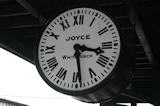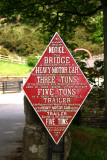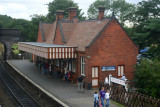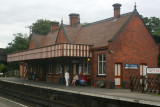Completed Projects (Newest First)
| Image | Date and Version | Description | ||
|---|---|---|---|---|
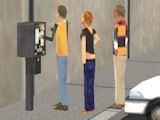 View | Install 1 item, 186 kb |
2010.06.05 TRS2004 |
Pay and Display 1
A representation of a machine that collects a fee and issues a ticket to be displayed on a parked vehicle as evidence that the correct fee has been paid. Or, in the event that the vehicle outstays its welcome, evidence that the incorrect fee was paid! This model is typical of such machines installed in car parks / parking lots and streetside in the United Kingdom. It might also be appropriate for other countries, since the textures are sufficiently vague to conceal any out of place currency symbols. |
||
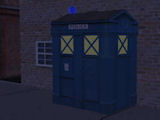 Box: View | Install Corona: View | Install 2 items, 246 kb |
2010.03.01 TRS2004 |
Edinburgh Police Box (1960)
A second model of the Edinburgh police box, this time depicting it during its operational lifetime (approximately the 1930s until the 1960s). Includes nightmode. The blue glow from the lamp at the left-hand end is a blue corona, which is a separate item that can be downloaded by clicking the link to the left. Acknowledgement: Once again, the textures for this model are based on photographs taken by tmz06003, and used with permission. |
||
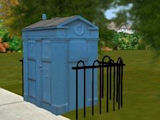 View | Install 1 item, 300 kb |
2010.02.12 TRS2004 |
Edinburgh Police Box (Derelict)
Like other British towns and cities, Edinburgh also made use of police telephone boxes. They were rather larger and more ornate than their London and Glasgow counterparts. Although I've not yet been able to confirm this, I suspect that their purpose was more as miniature police stations than as telephone boxes. A good number of these survive around Edinburgh. Many are in a fairly poor state of repair (as depicted in this model), but some have been refurbished as high-tech information points, while others have been converted, as in Glasgow, to serve as coffee kiosks. Acknowledgement: My thanks are due to a fellow Trainz enthusiast with the nom de chemin-de-fer of tmz06003, who photographed a surviving Edinburgh police box and kindly allowed me to use his photographs as the basis of the textures used in this model. |
||
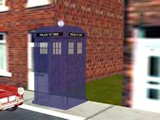 View | Install 1 item, 84 kb |
2009.11.30 TRS2004 TS2010 |
"Police Box 40"
Another variation on the police box theme. In Driver sessions, this item fades out of view and then fades back into view at random intervals. Suitable for all time periods, but not necessarily in the expected order... This item includes a file (readme.txt) with instructions on:
NOTE: This item does not function correctly in Trainz Simulator 2010. As far as I can tell, the problem arises changes to the Trainz scripting language which mean that objects "pop" into and out of view where they once faded in and out. On top of that, the rules for corona placement seem to have changed. I believe that these changes were introduced with TS2009, and therefore I assume that this item also does not function correctly in Trainz Simulator 2009. If I can fix the problem, I'll do so, but I can't guarantee that this will be possible. |
||
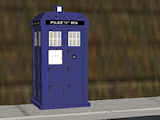 Met Mk1: View | Install Met Mk2: View | Install Wartime: View | Install City: View | Install 4 items Approx 115 kb each |
2009.11.06 TRS2004 |
London Police Boxes
These are the more well-know London police boxes, whose fame nowadays stems from reasons entirely unconnected with their original use. As with the Glasgow boxes, there were some minor detail differences:
|
||
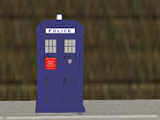 Red: View | Install Blue: View | Install Wartime: View | Install 3 items Approx 80 kb each |
2009.11.05 TRS2004 |
Glasgow Police Boxes
A representation of an emergency telephone box as used in Glasgow. The design is similar to the better-known London police box, although there are some minor detail differences. The Glasgow boxes allowed contact with the Fire Brigade and Ambulance Service as well as with the Police. Recognising their role as a general emergency, rather than police only, telephone, these boxes were initially red in colour, but were subsequently repainted blue. Police and emergency telephone boxes became redundant with the adoption of radio systems, and many of these boxes were demolished. A few survive, with some having found a new lease of life as coffee kiosks. There are three different versions of this model, differing in colour and nightmode:
|
||
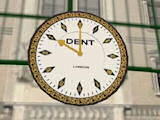 Blue1: View | Install Brown: View | Install Black: View | Install 3 items 630 kb each |
2009.04.17 TRS2004 |
St Pancras Station Clock
A very large station clock for very large stations. This model is based on the clock at London's St Pancras station, which has a diameter of 18 feet. The original was removed during refurbishment of the station in the 1970s and had been sold to a private collector. Unfortunately it was accidentally dropped in the course of its removal and badly damaged. The story then took a happier turn when the remains of the clock were salvaged by a retired railwayman who restored it (although not, as far as I'm aware, to working order). It is now mounted on the side of a barn in his garden in Nottinghamshire. (The British newspaper The Guardian ran a story about the saving of the original clock) In the recent reconstruction of St Pancras Station, a replica of the original clock was installed in the new train shed. There are three versions of this model, differing in the colour of the support brackets:
|
||
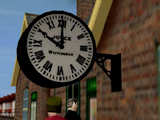 View | Install 1 item, 302 kb |
2008.10.22 (Update) TRS2004 |
Station Clock (Bracket)
A minor variation on a theme. This is essentially the same model as the "suspended" Station Clock, but I've slightly modified it so that can be attached to a wall by means of a bracket. Again, it includes Level of Detail modelling and a representation of tungsten lighting at night. |
||
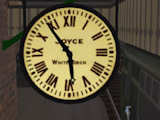 View | Install 1 item, 302 kb |
2008.10.22 (Update) TRS2004 |
Station Clock (Suspended version)
Something essential for any railway station - the station clock. It was somewhere to meet - and it told you the time too! I've now updated this asset to fix a minor timekeeping problem (it ran about 15 seconds slow) and to improve the modelling of the hands. The model depicts a clock of a design typical of those installed in British railway stations the steam and early diesel eras. I've based it on one formerly installed at Stalybridge station in Cheshire, which was built by the clockmakers J B Joyce of Whitchurch, Shropshire. The same makers also provided the Carnforth (Lancashire) station clock, which was made to a very similar design, so it's perhaps most at home in the North West of England. The Stalybridge clock was replaced with a modern replica several years ago, and the original is now displayed at the National Railway Museum in York, which gives modellers and other enthusiasts the chance to examine it at close quarters without exciting the sensibilities of security personnel. I've taken a few liberties with the dimensions, as the case of the original is deeper than I've made it here. Oddly, the version I made with the "correct" depth just looked wrong! This version is designed to be hung from a platform roof or canopy, and has a representation of supports. Adjust the height of the clock to hide the top of the supports in the rafters or to connect to a support beam. It includes Level of Detail modelling and is lit at night by the barely-adequate glow of tungsten lighting. |
||
 View | Install 2 items, 123 kb |
2008.04.07 TRS2004 |
Leaves on the Line!
Many of the trees in the UK are deciduous and lose their leaves during the autumn. Where this happens beside a railway line, and the weather is wet (which is not especially rare during a British autumn) the water and the dead leaves mix to form a slippery mess that can interfere with the grip between a train's wheels and the rails. When the phrase "leaves on the line" first appeared as a stated reason for a delayed service, its usage spread beyond the rail network and came to be applied to inadequacies in the service provided by many bodies. Its use is mainly ironic, and implies that the standard of service offered is deficient as a consequence of some level of undefined incompetence. This usage came about because cynical rail travellers soon came to suspect that the phrase was used as a convenient excuse for almost any delay, whether or not leaves played a role in causing that delay, that the Train Operating Company wanted to suggest was the fault of a capricious Nature, and not theirs at all. |
||
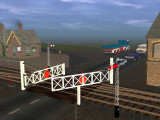 View Install level crossing Install control pack Install invisible road / rail Install node markers 14 items, 220 kb |
2008.03.25 TRS2004 |
"Whitecliffe St." Level Crossing
My most ambitious project to date - Whitecliffe St. Level Crossing. As my writings about this project expanded over the construction period, it has its own page. The Tutorials Page includes:
|
||

View | Install 25 items, 1.8 Mb |
2007.09.18 TRS2004 |
Speed Limit Warning Signs
Signs to warn drivers in advance that they are approaching a speed restriction have been in use on Britain's rail network since 1969. They were introduced in response to a fatal accident that occurred when a train approaching the Morpeth Curve failed to slow down to the posted speed limit. Various styles have been used over the years. This model represents a reflectorised design introduced in 1986, which remaining in use to the present day. More information about these signs can be found on Page 3 of Section 13 at the Railway Signs and Signals of Great Britain web site. 19th September 2007: Now updated to Version 2, to correct some small but annoying errors. I've also added some arrow symbols, to be added to the basic seed signs when the speed restriction applies to a diverging route. |
||
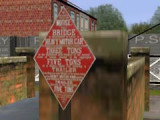
View | Install 1 item, 198 kb |
2007.06.12 UTC |
Weak Bridge Sign
A North Eastern Railway "weak bridge" warning sign. This pre-dates standard road signs, and since the lettering on the sign itself refers to the Motor Car Acts of 1895 and 1903, presumably it would have been made not long after those dates. This particular example can now be found on a bridge that crosses the Eller Beck on the approach road to the preserved North Yorkshire Moors Railway's Goathland station. |
||
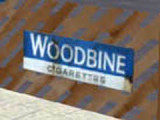
View | Install 1 item, 73 kb |
2007.01.16 UTC |
Enamelled Advertising Sign (Woodbines)
An enamel sign advertising Woodbines Cigarettes, from the days when advertising of cigarettes and other tobacco products was still permissible. I found the original for this sign on the "Poppy Line" (North Norfolk Railway) at Weybourne Station. It can be seen between the two doors on the nearer end of the main station building in the following pictures. |

|
Maintenance of way in progress. All visitors are advised to wear GO/RT 3279 compliant high-visibilty clothing This page was last updated 05 June 2010 |

